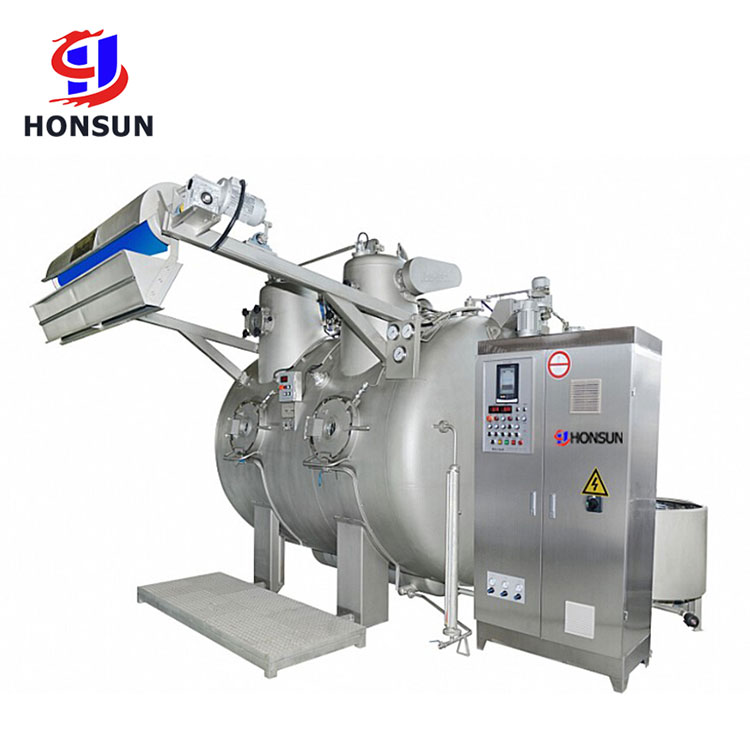Fabric Dyeing Machines: Essential Tools for Textile Industry Innovation
2025-05-19
The textile industry is an integral part of global manufacturing, playing a crucial role in producing fabrics and garments used in countless consumer products. Among the key processes in fabric production, dyeing stands out as an essential technique for adding color and design to raw fabrics. Fabric dyeing machines have revolutionized this process, allowing for high efficiency, precision, and consistency in producing a wide range of colorful fabrics. In this article, we will explore the significance of fabric dyeing machines, the different types available, and their impact on the textile industry.

What is a Fabric Dyeing Machine?
A fabric dyeing machine is a specialized piece of equipment used to apply dye to textile fibers. This process involves immersing the fabric into a dye solution that bonds the color to the fibers, resulting in a uniform and consistent finish. Fabric dyeing machines are designed to handle large volumes of fabric while ensuring the precise application of color without damaging the material.
These machines are used across various textile sectors, including fashion, home textiles, upholstery, and industrial fabrics. The choice of dyeing machine depends on factors such as the type of fabric being dyed, the required color fastness, and production volume.
How Do Fabric Dyeing Machines Work?
The dyeing process involves several steps, from preparing the fabric to finalizing the coloration. Fabric dyeing machines automate and control these processes, ensuring efficiency and uniformity. Here is a general overview of how these machines operate:
1. Fabric Loading: The fabric is loaded onto a reel or in a perforated basket, which is then placed inside the dyeing chamber.
2. Dye Solution Preparation: A precise mixture of dye, water, and other chemicals (such as fixing agents or salt) is prepared based on the fabric type and desired color.
3. Dye Application: The fabric is submerged in the dye solution. Depending on the machine type, the fabric may be continuously moved, agitated, or pressurized to ensure the dye is evenly absorbed.
4. Heating: Most fabric dyeing processes require heat to activate the dye and ensure proper bonding with the fibers. Some machines use steam or hot water for this purpose.
5. Washing and Rinsing: After the desired color is achieved, the fabric is rinsed to remove excess dye and any chemicals, ensuring the final product is clean and colorfast.
6. Drying: The dyed fabric is then dried using various methods such as hot air, steam, or centrifugal drying to remove moisture and complete the dyeing process.
Types of Fabric Dyeing Machines
Several different types of fabric dyeing machines are available, each designed for specific fabric types, production volumes, and desired dyeing effects. Some of the most common types include:
1. Jet Dyeing Machine: This machine uses high-velocity jets of dye liquor to circulate around the fabric, allowing for excellent penetration and even dye distribution. It is commonly used for delicate fabrics and synthetic fibers.
2. Pad Dyeing Machine: In pad dyeing, the fabric is passed through a dye solution on rollers or pads, and the excess dye is squeezed out. This method is best for applying dye to larger quantities of fabric, especially cotton, polyester, and blended fabrics.
3. Winch Dyeing Machine: This traditional dyeing machine operates by rolling fabric over a winch, which helps agitate the fabric while it’s in the dyeing solution. This type of machine is suitable for heavy fabrics such as wool and silk.
4. Beam Dyeing Machine: Beam dyeing is commonly used for large-scale dyeing of woven fabrics. The fabric is wound onto a beam, and dyeing occurs by immersing the beam into a dye solution. This method ensures consistent color application and is commonly used in textile mills.
5. Overflow Dyeing Machine: This machine is used for dyeing lightweight fabrics, where the fabric is suspended in a liquid bath that overflows through a funnel, allowing for even color distribution. It is highly effective in dyeing fine fabrics like silk, rayon, and delicate synthetics.
6. High Temperature and High Pressure Dyeing Machine: These machines are used for dyeing polyester and other synthetic fabrics that require higher temperatures and pressures to ensure dye absorption. They provide fast processing times and excellent color results.
7. Continuous Dyeing Machine: This machine allows fabric to pass through a series of dyeing and finishing stations continuously, making it suitable for high-volume production runs. It is commonly used for dyeing large quantities of woven or knitted fabrics in a consistent manner.
Advantages of Fabric Dyeing Machines
Fabric dyeing machines offer numerous benefits, which contribute to their widespread use in the textile industry:
1. Consistency and Precision: One of the main advantages of using fabric dyeing machines is the ability to achieve consistent color throughout a batch of fabric. These machines are engineered to deliver precise amounts of dye, ensuring uniform color distribution and avoiding color discrepancies.
2. Efficiency and Speed: Compared to manual dyeing methods, fabric dyeing machines significantly reduce the time and labor required for production. The machines can handle large volumes of fabric, making them ideal for high-throughput operations.
3. Cost-Effectiveness: While the initial investment in fabric dyeing machines may be high, they can save money in the long run. They reduce waste, minimize dye consumption, and require less manual labor, resulting in lower overall production costs.
4. Environmental Benefits: Many modern fabric dyeing machines are designed to be more environmentally friendly. They use less water and energy, and some are equipped with water recovery systems that recycle dyeing solutions. Additionally, advanced machines help reduce the use of harmful chemicals in the dyeing process.
5. Customization and Versatility: Fabric dyeing machines are highly customizable, offering various modes of dyeing that can be tailored to specific fabric types and colors. The machines can handle different dyeing techniques, including solid, gradient, and multicolor dyeing, allowing for a wide range of design possibilities.
Challenges and Innovations in Fabric Dyeing
While fabric dyeing machines have revolutionized the textile industry, several challenges remain. One of the primary concerns is the environmental impact of dyeing, particularly in terms of water consumption and wastewater disposal. However, innovations in the textile industry are addressing these issues. New dyeing technologies, such as air dyeing and digital printing, are being developed to reduce water and energy use.
Moreover, advancements in automation, smart sensors, and process optimization are improving dyeing efficiency. Automated systems can detect fabric defects and adjust dyeing parameters in real-time, ensuring optimal results with minimal waste.
Conclusion
Fabric dyeing machines have transformed the textile industry, offering precision, efficiency, and versatility in the production of colorful fabrics. These machines are indispensable in the dyeing process, from small-scale operations to large industrial setups. As the industry continues to focus on sustainability and efficiency, innovations in fabric dyeing technology will further enhance the capabilities of these machines, helping to meet the growing demand for high-quality, environmentally friendly textile products.
Whether for fashion, home textiles, or industrial applications, fabric dyeing machines play a pivotal role in the creation of vibrant, durable fabrics that meet the needs of modern consumers.


